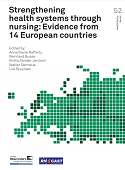Strengthening health systems through nursing: Evidence from 14 European countries (2019)

Download
by Anne Marie Rafferty, Reinhard Busse, Britta Zander-Jentsch, Walter Sermeus, Luk Bruyneel
2019, xv + 163 pages
ISBN 978 92 890 5174 3
CHF 40 / USD 48
Order no 13400205
‘Who is a nurse?’ and ‘What is nursing?’ seem to be simple questions yet the answers are strangely elusive. This book explores the variations in structure and organization of the nursing workforce across the different countries of Europe. This diversity, and the reasons for it, are of more than academic interest. The work of nurses has always had a critical impact on patient outcomes. As health systems shift radically in response to rising demand, the role of nurses becomes even more important.
This book is part of a two-volume study on the contributions that nurses make to strengthening health systems. This is the first time that the topic of nursing has been dealt with at length within the Observatory Health Policy Series. The aim is to raise the profile of nursing within health policy and draw the attention of decision-makers.
Part 1 is a series of national case studies drawn from Belgium, England, Finland, Germany, Greece, Ireland, the Netherlands, Norway, Poland, Spain, Sweden, and Switzerland. The countries were chosen as the subject of a large EU-funded study of nursing (RN4Cast). Lithuania and Slovenia were added to provide broader geographical and policy reach. Part 2, to be published later this year, will provide thematic analysis of important policy issues such as quality of care, workforce planning, education and training, regulation and migration.
The lessons learned from comparative case-study analysis demonstrate wide variation in every dimension of the workforce. It examines what a nurse is; nurse-to-doctor and nurse-to-population ratios; the education, regulation and issuing of credentials to nurses; and the planning of the workforce. While comparative analysis across countries brings these differences into sharp relief, it also reveals how the EU functions as an important ‘binding agent’, drawing these diverse elements together into a more coherent whole.



